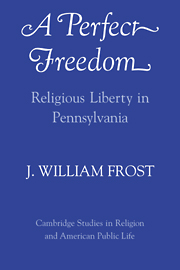Book contents
- Frontmatter
- Contents
- Acknowledgments
- Preface to This Paperback Reissue
- Introduction: The Pennsylvania Traditions of Religious Liberty
- I The Creation of Religious Liberty in Early Pennsylvania
- II Pacifism and Religious Liberty
- III The Clergy and Religious Liberty
- IV Religious Liberty in the Revolution
- V Religious Liberty and the Republic
- VI Politicians Debate Religious Liberty
- VII The Churches and Religious Liberty
- VIII The Legal Implications of Religious Liberty
- IX Religious Liberty and the Catholic and Jewish Minorities
- Epilogue: The Dismantling
- Notes
- Bibliography
- Index
II - Pacifism and Religious Liberty
- Frontmatter
- Contents
- Acknowledgments
- Preface to This Paperback Reissue
- Introduction: The Pennsylvania Traditions of Religious Liberty
- I The Creation of Religious Liberty in Early Pennsylvania
- II Pacifism and Religious Liberty
- III The Clergy and Religious Liberty
- IV Religious Liberty in the Revolution
- V Religious Liberty and the Republic
- VI Politicians Debate Religious Liberty
- VII The Churches and Religious Liberty
- VIII The Legal Implications of Religious Liberty
- IX Religious Liberty and the Catholic and Jewish Minorities
- Epilogue: The Dismantling
- Notes
- Bibliography
- Index
Summary
Pacifists and proponents of the military used their rights to liberty of conscience in debates over the Quaker peace principles. Most of the fighting in the English civil war (though not the invasions of Ireland and Jamaica) ended before the birth of Friends in 1652, and circumstances did not prompt Quakers to arrive at a consistent policy of pacifism before the Restoration. Alan Cole, Wayne Spurrier, and Barry Reay have discovered examples of Friends advocating the use of force or serving in the army during the last years of the Commonwealth, but these should be balanced against the pronouncements by Fox and other leaders of the nonviolent approach of Friends. The Quaker peace testimony became indelible only in 1660, and after the Restoration the policies of nonresistance, support of established authority, and no service in the military prevailed. Friends paid taxes to the government during war as a tribute to Caesar and a few weighty Friends affirmed a state's right to self-defense.
The charter to William Penn gave him responsibility to “Levy muster and traine” men, the rights of a “Captaine-generall of any Army,” and the ability “to make warr,” but during the first years of the colony these provisions were ignored. After the Glorious Revolution the imperial wars between England and France brought tensions to the New World, particularly to New England and New York.
- Type
- Chapter
- Information
- A Perfect FreedomReligious Liberty in Pennsylvania, pp. 29 - 43Publisher: Cambridge University PressPrint publication year: 1990



